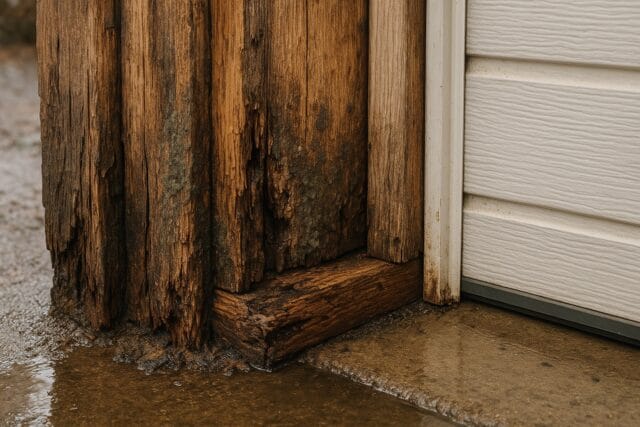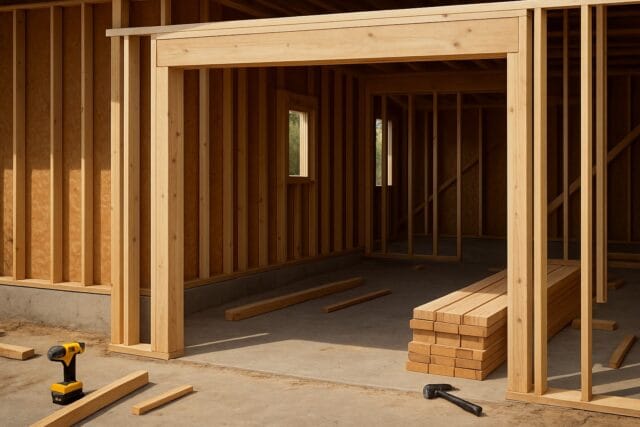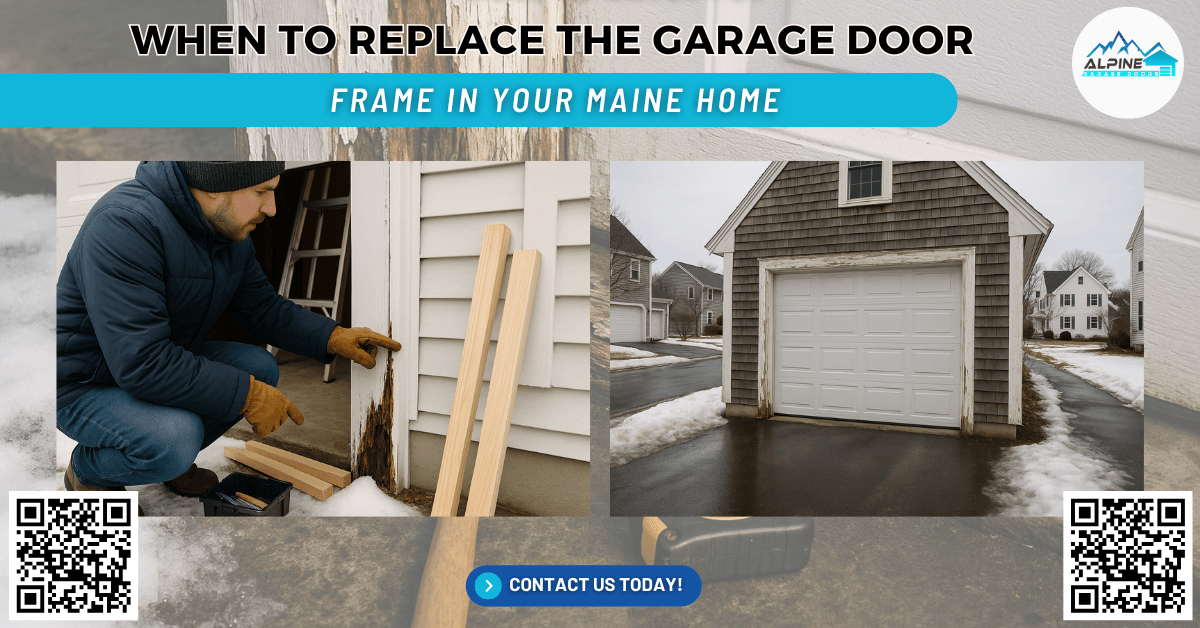Picture this scenario: A homeowner in Maine named Emily notices that her garage door no longer closes properly. Initially, she suspects a minor problem with the garage door opener, but as she examines the door closely, she finds the frame surrounding the door has several cracks and signs of rot. The door appears to sag, causing gaps along the edges and compromising the security of her home. Emily’s experience is far from uncommon. Many homeowners in Maine face similar issues with their garage door framing and often overlook the early warning signs that indicate a replacement is necessary. Understanding when to replace the garage door frame is critical not only to maintain the appearance and function of your garage door but also to ensure safety and security.
Garage doors are among the most frequently repaired components of residential and commercial buildings. Industry studies indicate that over 70 percent of garage door service calls relate to the frame, supporting header, or associated structural components. In regions like Maine, where winters are harsh, snowfall is heavy, and moisture levels fluctuate dramatically, garage door frames are especially vulnerable to deterioration. This is due to the impact of moisture, temperature changes, and pest activity that gradually weaken the frame’s integrity.
Knowing when to replace the garage door frame can save you significant time, money, and hassle. This comprehensive guide is designed to provide homeowners and contractors with essential information about the garage door framing, the structural support needed, and the building code considerations involved. Whether you are a Maine homeowner, a contractor preparing for a garage door installation, or someone curious about proper garage door framing practices, this article covers key elements such as rough opening dimensions, headers, framing materials, and installation guidelines to ensure your garage door operates safely and efficiently for years.
Understanding Garage Door Framing: What It Is and Why It Matters
The garage door frame is a critical structural component that surrounds the garage door opening. It provides the necessary support to hold the garage door securely in place and withstands the forces exerted by the door’s movement. Proper framing includes the rough opening for the garage door, supporting headers, king studs, jack studs, and additional reinforcements, all designed to distribute the load safely and comply with building codes.
The rough opening is the precise measurement of the space in the wall where the garage door will be installed. It is larger than the actual garage door opening dimensions to accommodate the door, its hardware, and necessary adjustments during installation. For example, a common rough opening width might be two inches wider than the door’s specified width to allow clearance and space for shims and leveling.
The supporting header for garage doors, often called a lintel beam or load-bearing header, is the horizontal framing member above the garage door opening. This header carries the weight of the wall and roof above, transferring loads safely around the garage door opening. Selecting and sizing the header is crucial to maintaining structural integrity. Many professionals use engineered lumber headers, such as laminated veneer lumber (LVL) or steel reinforcements, because they offer superior strength and resistance to warping compared to traditional wood headers.
The framing materials used for garage openings vary depending on the project’s requirements, environmental conditions, and building codes. Common framing materials include pressure-treated wood, moisture-resistant composites, steel studs, and engineered lumber. In Maine’s climate, moisture-resistant framing materials are highly recommended to prevent rot, warping, and pest infestation. Proper framing and header installation ensure that the garage door operates smoothly, remains level, and provides security.
Common Causes of Garage Door Frame Damage in Maine Homes
Several environmental and structural factors contribute to the damage seen in garage door frames, particularly in Maine’s climate.
Moisture and Wood Rot
Moisture is one of the primary causes of garage door frame deterioration. Wooden frames that are exposed to rain, snow, and humidity absorb moisture over time. Without proper sealing and maintenance, this moisture penetrates the wood, leading to fungal growth and rot. The bottom plates and jack studs around the rough opening are particularly vulnerable because they are close to the ground and may be exposed to water pooling or melting snow.

Warping and Cracking Due to Temperature Fluctuations
Maine experiences wide temperature swings, especially between winter and summer. Wood and metal framing materials expand and contract as temperatures change, which can cause warping, splitting, or cracking in the garage door frame. These issues can distort the rough opening width and cause misalignment of the door, resulting in poor sealing and malfunctioning openers.
Pest Infestation
Termites, carpenter ants, and other wood-destroying insects pose a significant threat to wooden garage door framing. Once pests have infested the framing materials, they compromise the structural support of the header and studs, increasing the risk of door failure. Inspections for pest damage should be routine in areas prone to infestation.
Physical Impact Damage
Garage doors and frames are sometimes damaged by accidental impacts such as vehicle bumps or falling tools. Even minor dents or cracks can weaken the framing over time, especially if left unrepaired. Metal frames can also suffer from rust or corrosion if protective coatings wear off, further reducing their load-bearing capacity.
Improper Installation or Non-Compliant Framing
Garage door framing that does not comply with building code requirements or that is improperly installed can fail prematurely. For example, incorrect measurements of the rough opening or use of undersized headers may lead to insufficient support for the door and the wall above. Code-compliant framing requires using proper header span tables, the correct number and placement of king studs and jack studs, and adherence to permitted framing specifications.
Recognizing the Signs That Your Garage Door Frame Needs Replacement
Early detection of garage door frame problems can prevent costly damage and maintain your garage’s safety and function. Here are detailed signs that your garage door frame likely needs replacement:
Visible Signs of Rot or Decay
When you inspect the garage door frame, pay close attention to any areas of discoloration, softness, or crumbling wood. Moisture-related rot typically appears as dark patches or mold on the surface. If you press your finger into the wood and it feels spongy or breaks apart easily, this is a clear indicator of advanced decay.
Warping or Large Cracks in the Frame
Frames that have bent or twisted out of shape can cause the garage door to misalign with the rough opening. Cracks running along the header or studs are signs of stress and structural weakening. Even small cracks can expand over time, compromising the frame’s load-bearing function.
Door Operation Problems
If your garage door sticks, jams, or closes unevenly, the frame may no longer be square or level. Misalignment caused by a damaged or warped frame can affect the door’s tracks and opener mechanism. If you hear grinding noises or notice gaps between the door and frame, it is time to investigate the framing.
Gaps or Drafts Around the Door
Gaps allow cold air, water, and pests to enter your garage. This not only affects energy efficiency but can also damage stored items or the garage door hardware. Poor sealing is often caused by a frame that has shifted or deteriorated.
Rust or Corrosion on Metal Frames
Metal frames exposed to moisture without adequate protection can rust and develop holes. Corrosion weakens the metal, making it unable to support the door properly. Rust stains on the frame or the wall nearby are warning signs.
Evidence of Pest Infestation
Look for sawdust piles, small holes, or visible insects near the frame. These are telltale signs that pests are compromising the wood’s integrity.
Why Replacing Your Garage Door Frame Is Often Better Than Repairing It
While minor issues such as small cracks or peeling paint may be repaired, many problems with garage door framing require full replacement for long-term safety and performance. Here are reasons why replacement is generally the preferred option:
- When damage affects a large portion of the frame, patch repairs will not restore sufficient structural support.
- If the frame no longer properly supports the header or the load above, there is a risk of wall or roof damage.
- Pest infestation that penetrates deep into the wood cannot be fully eliminated with repairs.
- Frequent repairs suggest underlying moisture or structural issues that replacement can address permanently.
- A compromised frame jeopardizes the security of your home and the safe operation of the door.
The Process of Garage Door Frame Replacement Explained
Replacing a garage door frame is a skilled task that requires adherence to building codes, precise measurements, and knowledge of framing materials. Here is an expanded overview of the replacement process:
Step 1: Comprehensive Inspection and Measurement
A licensed contractor or technician begins by inspecting the existing frame, measuring the rough opening width, height, and depth, and assessing the condition of the supporting header, king studs, and jack studs. They also check for compliance with local building codes and permit specifications.
Step 2: Careful Removal of the Existing Frame
Removing the damaged frame without disturbing the door or the surrounding walls requires skill and proper tools. This includes detaching the garage door from its tracks temporarily and removing any nails, screws, or fasteners securing the frame.
Step 3: Preparation of the Rough Opening
The rough opening is cleaned and leveled using shims and levels to ensure the new frame fits perfectly. Any damage to the surrounding structure, such as rot or pest damage in adjacent studs, must be repaired before proceeding.
Step 4: Installation of the New Header and Framing Members
The new header, typically an engineered lumber header like laminated veneer lumber (LVL) or a steel lintel beam, is installed to support the load above the garage door. The header is sized based on span tables, which account for opening width and roof loads. King studs and jack studs are installed on either side of the rough opening to transfer weight from the header to the foundation.
Step 5: Ensuring Code Compliance and Structural Support
All framing work must meet local building code requirements, including permitted framing specifications and the use of load-bearing headers where necessary. Reinforced framing for garage doors is essential in areas prone to heavy snow or wind loads.
Step 6: Final Adjustments and Door Reinstallation
After the frame is installed, the garage door is reattached and tested. The technician checks that the door opens and closes smoothly, seals tightly without gaps, and that the opener functions without strain on the frame.
Selecting the Right Framing Materials for Garage Door Installation in Maine
Material choice has a major impact on the longevity and performance of garage door framing. Here are common options explained in detail:
Pressure-Treated Wood
This is a popular choice for framing because it is affordable and widely available. Pressure-treated lumber is chemically treated to resist moisture and insects, but it still requires regular maintenance in Maine’s harsh climate.
Engineered Lumber Headers
Engineered lumber such as LVL is manufactured to precise specifications, offering superior strength and resistance to warping compared to traditional wood. These headers are ideal for large garage door openings and are commonly used as load-bearing headers.
Steel Framing Components
Steel lintel beams and steel studs offer excellent durability and pest resistance. They are especially useful in commercial installations or homes where minimal maintenance is preferred. However, steel must be properly coated or galvanized to prevent rust.
Composite and Moisture-Resistant Materials
Composite materials combine wood fibers with resins to create framing that is more resistant to moisture and pests. These materials are gaining popularity due to their durability and low maintenance.

Maintaining Your Garage Door Frame for Maximum Longevity
Once your garage door frame is replaced or properly installed, regular maintenance is vital to preserve its function and appearance. Some key maintenance tips include:
- Inspect the framing for signs of wear, moisture, or pests at least twice a year, especially after winter.
- Ensure gutters and drainage systems direct water away from the garage door framing.
- Apply water-resistant sealants or paint on wooden frames annually to prevent rot.
- Promptly remove snow and ice buildup to avoid moisture damage.
- Treat any signs of pest infestation immediately with professional extermination.
- Lubricate the garage door hardware to minimize stress on the frame and prevent mechanical damage.
Understanding Building Code Requirements for Garage Door Framing
Building codes specify the requirements for garage door framing to ensure structural safety and durability. This includes:
- Minimum rough opening dimensions relative to the garage door size.
- Approved materials for framing and headers.
- Load-bearing header sizing based on span tables considering roof and wall loads.
- Proper installation of king studs and jack studs to transfer loads correctly.
- Requirements for shims, levels, and fasteners during installation to achieve code-compliant framing.
- Inspection and permitting protocols before and after framing installation.
Contractors must follow local building codes and permit specifications to avoid fines, safety hazards, or future structural issues.
The Risks of Neglecting Garage Door Frame Problems
Ignoring the signs of a failing garage door frame can lead to dangerous and costly consequences. Structural failure could cause the garage door to fall or become stuck, potentially injuring people or damaging property. Poor framing also results in increased heating costs due to air leaks and moisture intrusion, which can damage stored items and encourage mold growth. Additionally, a weak frame compromises home security by making forced entry easier.
Frequently Asked Questions (FAQs)
Q1: How do I measure the rough opening width for a new garage door?
To measure the rough opening width, measure the distance between the inside edges of the framing studs where the garage door will be installed. It is important to take measurements at the top, middle, and bottom to ensure the opening is square and consistent.
Q2: Can I install a garage door frame without a permit?
Permit requirements vary by location, but most municipalities require a permit for garage door frame replacement to ensure code compliance and safety. It is best to check with your local building department before beginning any framing work.
Q3: How long does a typical garage door frame last before needing replacement?
The lifespan of a garage door frame depends on the materials used, climate conditions, and maintenance, but generally, a well-maintained frame can last 20 to 30 years. Frames exposed to excessive moisture or pests may require earlier replacement.
Q4: What is the difference between king studs and jack studs in garage door framing?
King studs are full-length vertical studs that run from the bottom plate to the top plate of the wall, providing main structural support. Jack studs, also called trimmer studs, are shorter and support the header by transferring its load down to the foundation.
How Can Alpine Garage Doors New England Help You?
At Alpine Garage Doors New England, we specialize in garage door framing and installation services tailored to the demanding Maine climate and local building codes. Our experienced team understands the critical importance of properly sized headers, reinforced framing, and code-compliant installation to ensure your garage door operates smoothly, safely, and efficiently.
We provide comprehensive inspections, expert assessments, and high-quality replacement services for garage door frames. Whether your current frame shows signs of rot, warping, pest damage, or structural failure, we offer durable solutions using premium materials such as engineered lumber headers and moisture-resistant framing components.
As a trusted contractor serving Connecticut, Massachusetts, and surrounding areas, Alpine Garage Doors New England is committed to customer satisfaction and adherence to all building codes and permit specifications. We guide you through the entire garage door framing installation process, from precise measurements of the rough opening to professional header installation and final door setup.
Contact us today for a free consultation or to schedule an inspection and quote. We are ready to help you safeguard your home with a strong, code-compliant garage door frame designed to last.
Visit us at: 150 Cross St, Boston, MA 02109
Call us: (617)-865-7222
Trust Alpine Garage Doors New England for expert garage door framing, installation, and repair services that keep your garage secure and functional year-round.
Final Thoughts
Your garage door frame plays a vital role in the structural integrity and operation of your garage door. Understanding the importance of the rough opening dimensions, supporting header size, framing materials, and code compliance can help you make informed decisions about maintenance or replacement. In Maine’s climate, moisture-resistant materials and proper installation are key to preventing rot, warping, and pest damage that often necessitate frame replacement.
Early detection of frame problems through regular inspection allows you to avoid costly repairs and safety risks. When damage is extensive or the frame no longer supports the door properly, replacement is the safest and most cost-effective solution. Working with a professional contractor who understands building codes, proper measurements, and installation techniques ensures your garage door framing will be strong, secure, and long-lasting.
Take proactive steps today by scheduling an inspection with a trusted garage door specialist. Maintaining your garage door frame not only protects your investment but also enhances the safety, energy efficiency, and curb appeal of your Maine home.
If you want a trusted partner who can provide expert advice and professional garage door frame replacement services, Alpine Garage Doors New England is here to help. Call us or visit our office to learn more about our services and how we can keep your garage door performing at its best.

